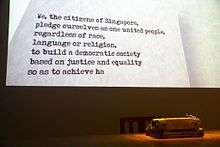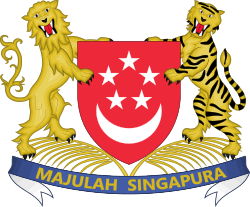Singapore National Pledge
The Singapore National Pledge is an oath of allegiance to the flag of Singapore and the Republic of Singapore. It is commonly recited by Singaporeans in unison at public events, especially in schools, in the Singapore Armed Forces and during the National Day Parade.
| Singapore National Pledge | |
|---|---|
| February 1966 (first version) | |
| “We, as citizens of Singapore, pledge ourselves to forget differences of race, language or religion and become one united people; to build a democratic society where justice and equality will prevail and where we will seek happiness and progress by helping one another.” | |
| August 1966 (current version, per Constitution of Singapore) | |
| "We, the citizens of Singapore, pledge ourselves as one united people regardless of race, language or religion, to build a democratic society based on justice and equality so as to achieve happiness, prosperity and progress for our nation. |
| Part of a series on the |
| Culture of Singapore |
|---|
 |
| History |
| Topics |
|
| Research |
| Symbols |
|

In October 1965, William Cheng, Principal Assistant Secretary of Administration of the Ministry of Education, mooted the idea of a pledge to inculcate national consciousness and patriotism in schools. The idea gained the support of then Minister for Education, Ong Pang Boon, who gave the task of drafting the pledge to Philip Liau, Advisor on Textbooks and Syllabuses, and George Thomson, Director of the Political Study Centre.
Ong sent the two drafts to S. Rajaratnam, then Minister for Foreign Affairs, for his comments. After that, the draft underwent another round of revisions by Ministry officials as well as then Prime Minister Lee Kuan Yew before submission to the Cabinet for final approval.
From August 1966 onwards, students began reciting the National Pledge before the start of each school day. As not many schools then had open areas for morning assemblies, the Pledge was initially recited mainly in classrooms. Since then, the National Pledge has been recited during National Day occasions, the National Day Parade and school assemblies. The original English text was also translated into Chinese, Malay and Tamil.
According to S. Rajaratnam, the Pledge emerged against the backdrop of a vital struggle to forge a sense of nationhood and build “a Singapore we are proud of”. He believed that language, race and religion were potentially divisive factors and used the Pledge to emphasise that these differences could be overcome if Singaporeans were united in their commitment to the country.[1]
The Pledge
The National Pledge is:
- English version
“We, the citizens of Singapore,
pledge ourselves as one united people
regardless of race, language or religion,
to build a democratic society
based on justice and equality
so as to achieve happiness, prosperity
and progress for our nation."
An earlier version was suggested by Minister of Culture (later Deputy Prime Minister) S. Rajaratnam in a letter to Ong Pang Boon, the Minister for Education in a letter dated 18 February 1966. It reads:
“We, as citizens of Singapore,
pledge ourselves to forget differences
of race, language or religion
and become one united people;
to build a democratic society
where justice and equality will prevail
and where we will seek happiness
and progress
by helping one another.”[2]
- Malay version
Kami, warga negara Singapura,
sebagai rakyat yang bersatu padu,
tidak kira apa bangsa, bahasa, atau agama,
berikrar untuk membina suatu masyarakat yang demokratik,
berdasarkan kepada keadilan dan persamaan untuk mencapai kebahagian,
kemakmuran dan kemajuan bagi negara kami.
- Chinese version
| Simplified Chinese | Pinyin |
|---|---|
|
我们是新加坡公民, |
Wǒmen shì Xīnjiāpō gōngmín, |
- Tamil version
| Tamil script | Romanization |
|---|---|
|
சிங்கப்பூர் குடிமக்களாகிய நாம், இனம், மொழி, மதம் |
Singapoor kudimakkalaagiya naam, inam, mozhi, madham |
Guidelines for usage
The Singapore government's guidelines for the use of the pledge are:
- The National Pledge is recited in schools on all school days, either in the morning or afternoon, during SAF Day, during the National Day Parade, and at National Day Observance Ceremonies.
- Individuals reciting the Pledge shall clench their right fists to the left side of their chests as a gesture to symbolise loyalty to the nation.
- The Pledge shall not be used for any commercial purposes. (However, the pledge is used as the bridge of the 1987 National Day song "We are Singapore" and the 2018 National Day song "We are Singapore" (adapted from the 1987 National Day song.))
